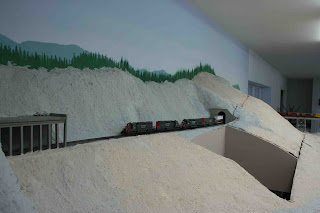My terrain forming efforts finally turned to filling in the gap alongside Cruzatte. Below Cruzatte are my Tunnel 20 and the RR-East end of Wicopee. With my narrow shelf construction around the walls, the terrain slope must be steep. While I might have spread the distance between the lower line, including Wicopee, I chose to keep the layout space narrow for easier access to Cruzatte and to provide for wider operator aisles. I hope to conceal some of this with trees, but for now, the base terrain emphasizes the height difference between the two lines.
Terrain construction followed my now-familiar pattern of establishing top and bottom bases for sloping Styrofoam slabs. I tried to provide a few bump-outs and outcroppings to break up the otherwise flat slabs. I also was able to angle a few of the slabs and indent them to break up the surfaces.
Terrain base between Cruzatte above and RR-East Wicopee below.
Several special requirements were catered to during the construction. First, I finally needed to build up abutments and then fill around Cascade Creek. Cascade Creek is spanned by a pair of deck girder bridges toward the RR-East end of Cruzatte. A waterfall is on the uphill side of the railroad. I needed both the uphill waterfall and another one on the downhill side. The lower waterfall needed to "flow" into a creek that I chose to route along the tracks to join Noisy Creek. All of this eventually becomes Salt Creek on my railroad. Consider this the compromise necessary with selective compression of the real geography to fit into a basement layout space.
Cascade Creek formed with waterfalls on both sides of the tracks.
Another terrain issue was providing access hatches. One of these was the second hatch covering the footpad for access to the deep part of the Shady Creek scene. I used three-inch thick Strofoam to help form the opposing terrain forms for this hatch. I then formed long terrain slabs from Tunnel 8 above down to the base near the lower track below, attaching them with caulk to both of the three-inch terrain formers. Finally, I used a saw to cut the top shell slabs, using the slight gap between the formers to guide the saw.
Cutting the upper end of the hatch covering the footpad for Shady Creek access. Tunnel 8 at the RR-West end of Cruzatte is above. The lower track connects McCredie Springs to Wicopee.
I also needed to provide hatches for access to future signal locations. Four signal assemblies will be installed at Cruzatte--two at each end. Most of these hatches were simple affairs of two 4-inch wide Styrofoam slabs glued together with a reinforcing slab and propped between the lower base and the plywood subroadbed for Cruzatte. One of the hatches needed to be wider to account for a support arm for the Cruzatte roadbed. The exact signal location may fall on either side of this support, so I used a 16-inch wide Styrofoam slab for this hatch. Each hatch has some sort of extra formation to break up the otherwise flat slab.
RR-East Cruzatte signal access hatches removed.
After filling gaps and adding to the slab formation with spray insulating foam, I carved and shaped the terrain slabs. Finally, I added the Sculptamold. It took two separate three-hour sessions to cover the very large area of this new terrain work. I used a stiff Sculptamold mixture to counter the steep slopes and the even steeper undersides of the many outcroppings. Fortunately, such stiff mixtures set up a bit quicker--overnight versus a couple of days with wet mixes.
SPX9232W climbs up through East Cruzatte and over Cascade Creek.
SPX9232W rolling through the RR-West end of Cruzatte. The full expanse of the new terrain can be seen extending between the tunnels at each end of Cruzatte.
Filling in the terrain below Cruzatte completes most of the terrain formation along forty feet of my basement wall. One easily imagines being in the mountains. There is a lot less bare plywood showing!

































